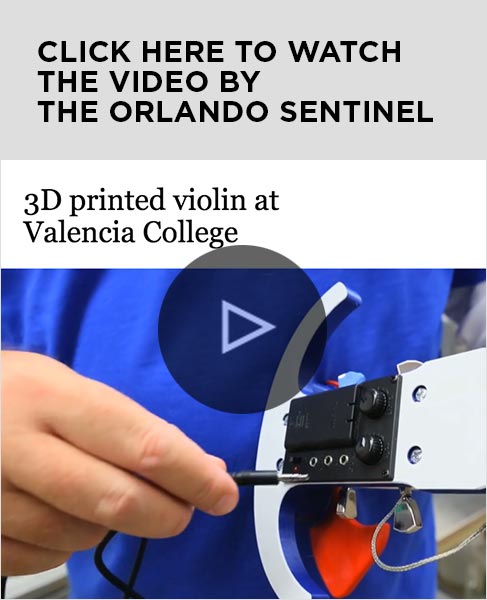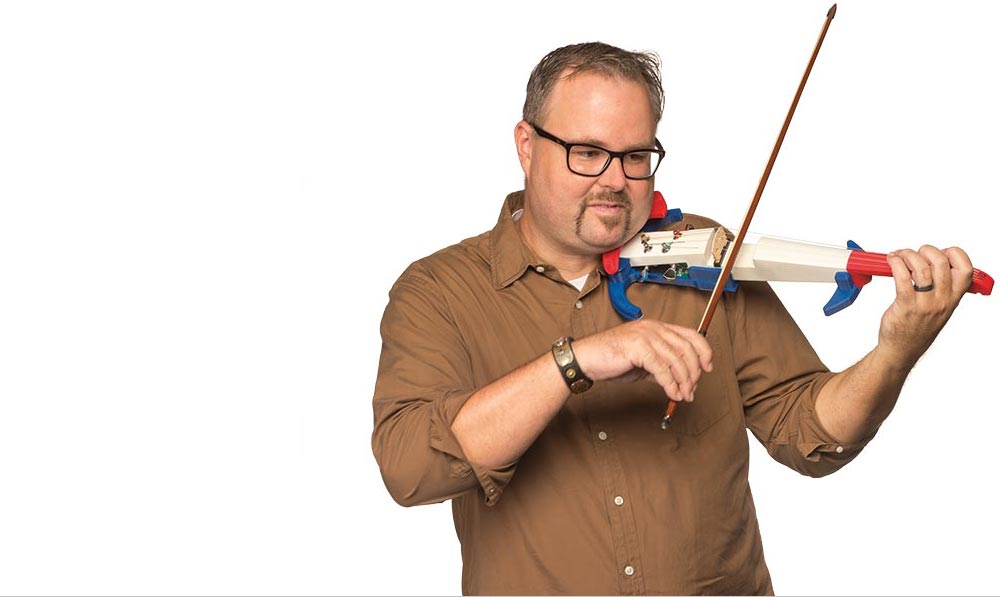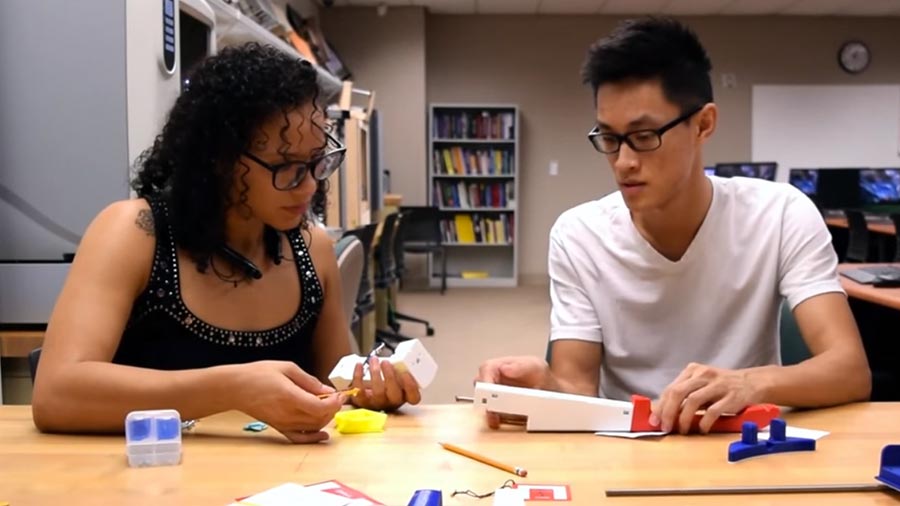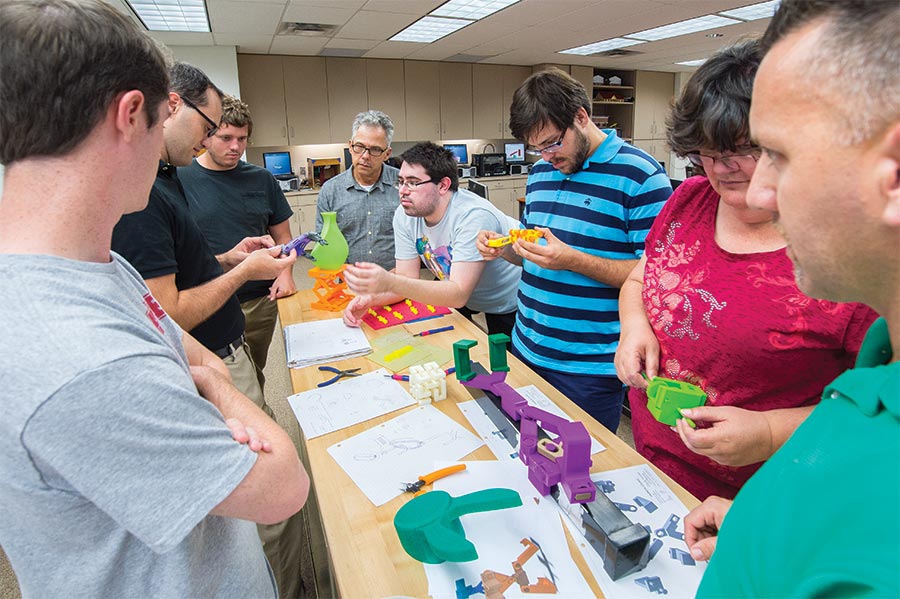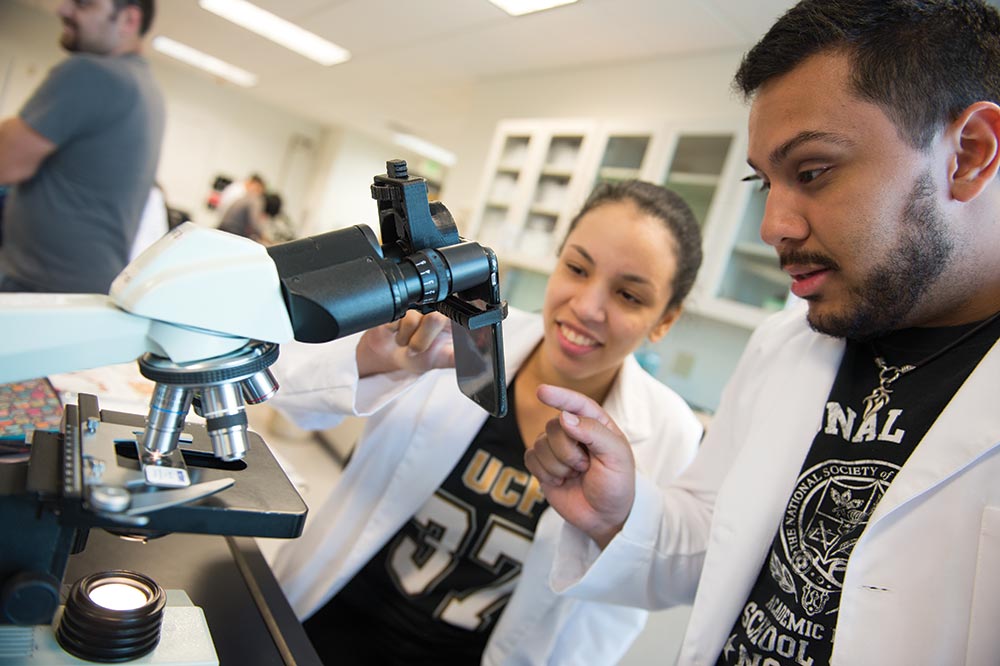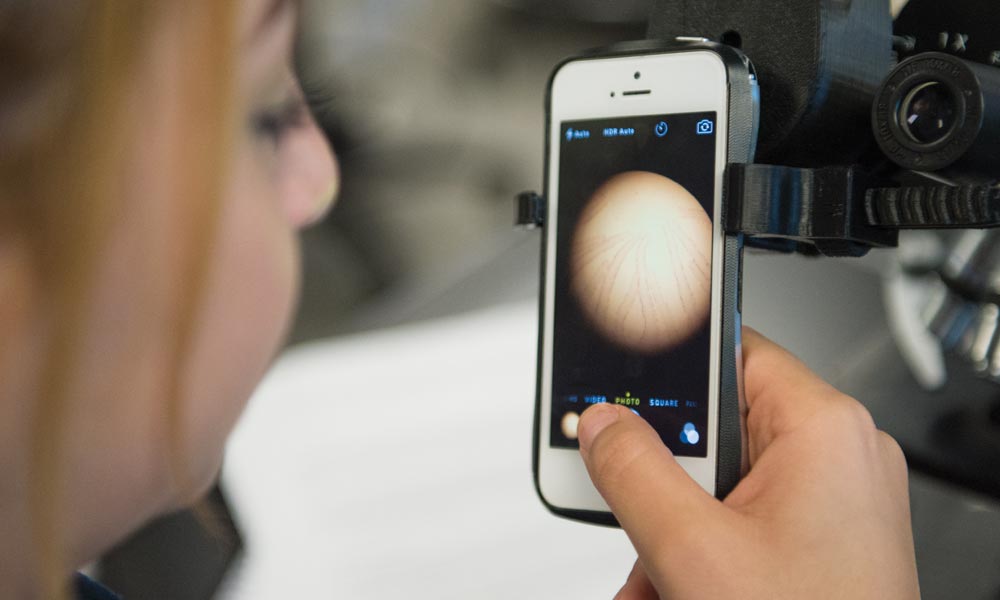//BY MELISSA TCHEN
As an electric violin emerges from Valencia’s 3-D printing lab, it represents a new era of design. From modifying the classics to developing modern innovations, designers are harnessing the power of 3-D printers to quickly and inexpensively bring ideas to life.
A few months ago, English professor Neal Phillips didn’t know much about 3-D printing. Now he considers himself an enthusiast.
Being the first person to get to play a 3-D printed electric violin will do that to a musician.
The violin, which was produced and assembled in the 3-D printing lab on Valencia’s West Campus, was the result of a summer-long side project that lab manager Pat Lynch devised for her lab assistants.
Lynch had been looking for a challenging project to help her lab assistants improve their skills while also keeping the printers running when classes weren’t in session during the summer.
When Lynch saw the violin on thingiverse.com, an online community for sharing 3-D printing designs, she knew she had found the right project.
“I thought it would be a really good project,” says Lynch. “When you’re done, you don’t just have a piece of plastic—you have a functional instrument.”
Phillips, an experienced violinist, was recruited to test the violin after it was complete. It played wonderfully—so much so, that he’s been using it onstage during performances with his country-rock band, Spayed Koolie.
“It works like a traditional violin. It just plays beautifully when it’s amplified,” says Phillips. “It’s sharp-looking too.”
While it may play like a traditional violin, it certainly was not produced traditionally.
Neal Phillips performs on Valencia’s 3-D printed electric violin.
Made to Print
3-D printers create real objects from computer-generated 3-D models. They work much like traditional printers, but instead of ink, they print material (usually plastic) layer by layer until the desired object is built.
Valencia’s 3-D printing lab has nine printers in seven different models—many of which have been donated by local companies and industry partners. Most look like small microwaves or toaster ovens.
It’s the job of the lab manager and her assistants to know the printers inside and out in order to keep the machines running smoothly for students enrolled in 3-D printing and rapid prototyping courses.
“I was pretty familiar with all the printers in the lab,” says former lab assistant, Andrew Ton. “So going from what I knew to trying to print the violin was pretty easy, but it still took some refining. Some pieces required special attention. We picked and chose printers based on their strengths and weaknesses.”
The most commonly used printers in the lab only have a 6-inch printing bed, limiting the size of the products they can make. To accommodate for this, the violin was printed in three pieces that could be fitted together, rather than as a whole.
The lab’s standard, smaller machines are able to print very inexpensively—a 2-inch donut-shaped ring costs 17 cents to print. By comparison, one of the larger (and also faster and higher quality) machines will print the same shape for $18.
Although the plastic filament used for making the prints come in all colors—from red, green and blue to fluorescent, glow-in-the-dark and even wood grain—the lab rules prohibit changing out the color spools on the large machines until the previous one runs out.
This cost-saving measure is how Lynch and her lab assistants ended up with a patriotic violin.
“The printer happened to have red filament at the time and at some point the white filament got swapped out for blue and voila—red, white and blue,” explains Lynch.
After all the pieces were printed out, then came the challenge of assembling the violin. That meant trips to home improvement stores and online shops to find the right parts, screwing and gluing the printed pieces together, and figuring out how to string a violin.
“I didn’t think it’d be that hard,” says Ton. “We thought we could just watch a YouTube video on how to string a violin, but we ran into a bunch of roadblocks, which extended the process.”
With each attempt to print and assemble the violin came the opportunity to learn and make subtle improvements for the next go-round. And it all paid off in the end, when they were able to hear the violin play.
“It was really exciting, like ‘wow, we just did something that can create music’—and we printed it,” says Ton, who is now studying IT at the University of Central Florida.
Playing it Forward
As with many 3-D printed products, the violin cost much less than a traditionally manufactured instrument would. A Yamaha electric violin sells for about $750. Lynch’s violin cost only $121.87, including all printing filament, hardware and strings.
Lynch estimates that she could get the cost down to under $100 simply by printing one of the pieces on a more cost-effective printer.
It’s this kind of affordability that presents opportunity—potentially to print more violins for underprivileged children interested in playing the instrument. It’s something that Phillips hopes can be explored.
In the meantime, Valencia’s violin is already being used to help youth in another way— leveraging the wow factor of 3-D printing to get elementary-school children excited to learn about STEM (science, technology, engineering and mathematics) and STEAM (which adds “arts” to the acronym).
Recently, Lynch and Phillips teamed up to present during STEM night at Stenstrom Elementary School in Oviedo. The elementary-school students were able to see 3-D printers in action, learn about how Valencia’s violin was made, hear it perform and were even given the chance to play it.
“They could all relate to a musical instrument,” says JoAnn Archer, STEM teacher at Stenstrom Elementary. “To say, ‘hey we printed this from a 3-D printer, and look at how great it sounds and what it does,’ it was very engaging for them.”
The violin also stood as an example of how STEM can be applied across disciplines.
“When you think STEM, you think of engineering, our tech corridor, defense contracts, space—and while that’s important, we want students to see how STEM is being incorporated into other fields as well,” says Archer. “That’s why we zoned in on that violin—here’s an example of how a musician is using technology to improve what they’re doing.”
Educating the Future
STEM education is becoming increasingly important, as the future job market will require more employees who possess skills in those areas—including those who can operate and design for 3-D printers.
Before 3-D printers, new designs had to be manufactured, which could take months and cost thousands of dollars in tooling and production. 3-D technology allows designers to test ideas and make subtle refinements to prototypes cheaply and quickly before investing in expensive molds.
Local companies such as Siemens and Lockheed Martin can use 3-D printers to rapidly prototype new ideas onsite. When they want to create a new tool or product, they can rapid prototype it for pennies, tweak as needed and get a final product out much faster.
Other applications for 3-D printing include prosthetic devices, printing of brain scans, architectural models and crime scene documentation, just to name a few.
Valencia students who complete the Rapid Prototyping Specialist certificate through the Drafting and Design Technology Associate in Science program are learning design and printing skills that can make them more employable, says Andy Ray, program chair.
“Several of our partners, in drafting especially, have hired our students as interns, and graduates
as well. Their companies are increasingly using rapid prototyping and need employees trained to use this technology.”
Ideas in 3-D
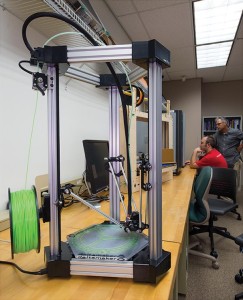
An open-air 3-D printer provides a full view of the printing process.
Employers who hire Valencia’s 3-D students gain more than technicians who can operate 3-D printers—they get creative problem-solvers.
In professor Tommy James’ Intro to 3-D Printing class on the West Campus, the students are still mastering the basics of 3-D printing, but more than that, they are learning to think like designers.
The students are taught to take a concept from an idea in their mind, to a sketch on paper, to a 3-D computer model, to a physical 3-D print. Then, after a group review, they must revise and reprint until they are satisfied with the product.
On presentation day early in the fall term, the students prepare to share their latest prints—designs that solve a problem. The assignments are purposefully open-ended, to give the students plenty of room for creativity.
Student Elizabeth Treat, nicknamed “Her Majesty,” heads to the front of the class to present her solution for a cookbook holder. Previously, Treat had trouble finding a bookstand that wouldn’t fall over under the weight of large cookbooks, or that could keep the pages from flipping open.
Almost as soon as she pulls her presentation up on the screen at the front of the class, the peanut gallery comes to life. “Hey, weren’t you supposed to cook us something?” “Yeah, where’s our food?” “Hey, how do we know this thing really works?”
In a class where critiquing is a key element of collaboration, some gentle ribbing is part of the camaraderie. So are nicknames. In addition to Her Majesty, there’s Blue, Little John, Sky, Boy Scout and La La.
After Treat’s presentation comes to an end, the group converges on her model. They pass it to one another, picking it up, testing the joints, opening and closing it, even trying to bend it and break it. The stand holds steady.
“So, is this a success?” asks James. The group unanimously agrees that it is. “Now how can we improve it?”
James pushes the students to think of ways the product could be made more universal. Could it be mounted to kitchen cabinets to sit at eye level? Could the slots in the back be given a purpose? Everyone starts to chime in, building off each other’s ideas—it could be adjustable to hold a smartphone, or a tablet, or index-sized recipe cards. By the time they are done, Treat has a list of ideas for improving her already successful product.
This cycle of design, print, test, tweak and repeat is called rapid prototyping—and it’s changing the face of design.
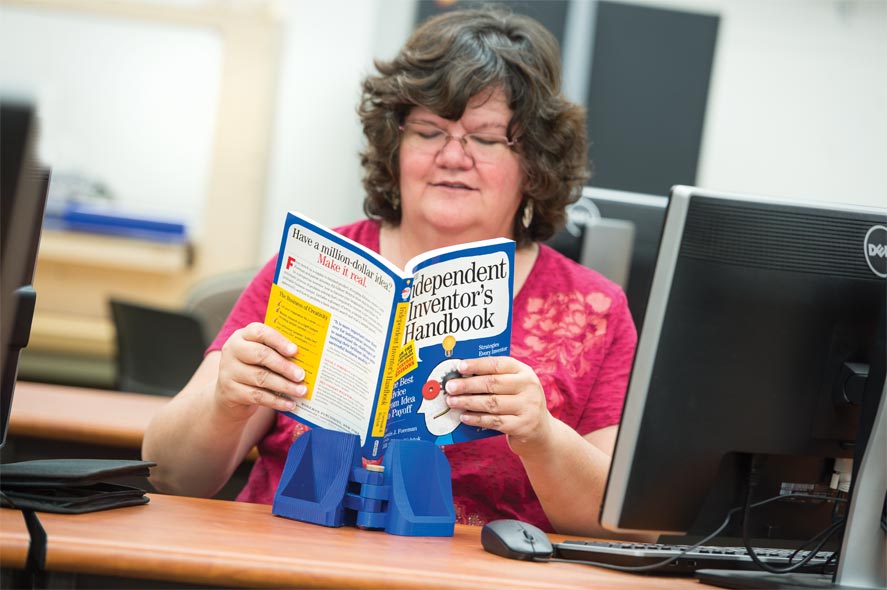
Elizabeth Treat tests her 3-D printed cookbook holder.
Rapid Prototyping
Student Josue Gimbernard, who has completed Valencia’s Rapid Prototyping Specialist certificate, estimates that he’s already gone through more than 100 prototypes for his invention, which he’s calling MicroSnap. The product is an attachment that allows science students to mount their smartphones to microscopes in order to photograph what they’re observing.
Although digital microscopes exist, they are very expensive, costing up to $3,000, which most schools can’t afford. And the photo quality is not as good as that of a standard smartphone.
“Up until this point, students have been relying on hand drawings to capture or save whatever they’re looking at through a microscope,” explains Gimbernard, who has filed for a patent on his invention. “Now students can just put their phone right onto the eyepiece to take photos or video.”
The idea for Gimbernard’s product originated as a project in James’ Advanced Rapid Prototyping class, where the students were tasked with making a tool for their phones.
Gimbernard, who’s always had a love for the sciences, enjoyed studying biology with his now 9-year-old daughter. Wanting a way to record the things they looked at, he shelled out $500 for a camera that would work with a microscope. But the picture quality wasn’t very good. One day, he started trying to hold his phone camera over the lens and realized if he could align everything just right, he could get a much better quality photo.
But aligning the hole of the camera with the hole of the microscope lens was difficult to do manually. With his 3-D printing skills, Gimbernard could make an apparatus to hold the two together.
At first, he created a product that worked just for his phone and his microscope, but through the rapid prototyping process, he was able to quickly rework his design so that it could accommodate any smartphone and any microscope.
Gimbernard already has a potential investor lined up for his product, which is currently being tested by Valencia biology students as well by ophthalmologists at Nemours Children’s Hospital.
“It’s been a huge learning process,” says Gimbernard. “Now it’s to a point where it looks good and the students get it and it’s easy, it’s printable, I’d like to know if it works well on a large scale.”
A Working Prototype
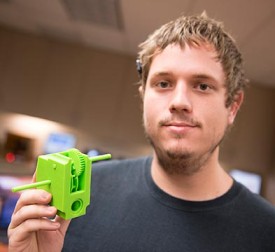
Trent Slater shows off his working prototype.
Student Trent Slater, who has completed Valencia’s Rapid Prototyping Specialist certificate, is currently employed at a local company that manufactures boat trailers and gun parts. He also has a 3-D printer at home that he uses for personal projects.
“Every day I look for something to print,” says Slater. “Every time I come across a problem, I try to think if I can use [the 3-D printer] as a medium to solve it. It makes you look at things differently—if I could make something rather than buying it or taking it somewhere to get it fixed.”
One problem that Slater noticed at work was that it took three people a full day to hand-polish finished gun parts. He decided to use his personal 3-D printer to prototype a more efficient solution. He came up with an idea for a “hydraulic live tooling block”—an automatic polishing tool powered by coolant fluid already inside the manufacturing machines.
Currently, Slater has a working prototype and is waiting for the right timing to present the idea his boss, to hopefully be incorporated into the company’s manufacturing process.
Tune Changer
Back in the 3-D printing lab, there are still improvements to be made on the electric violin.
Phillips is serving as a design consultant for improving how the violin plays. His top two recommendations are to make the chinrest more comfortable and to modify the neck so that the left hand can slide up and down more easily in order to reach the strings.
After making Phillips’ recommended changes, Lynch plans to modify the original designs and post them back to thingiverse.com. The 3-D printing community is very collaborative, building off each other’s ideas and sharing updated designs online. Working together virtually reinforces the benefits that 3-D printers have had on design—the ability to improve designs quickly and inexpensively.
And Phillips sees Valencia at the forefront of improving the design of 3-D printed violins.
“I look at it as kind of the equivalent of the space shuttle Columbia—the first one that’s actually working and being used,” says Phillips. “Valencia’s right in there with the top two or three to get out there first. We’re on the cusp of this.”

